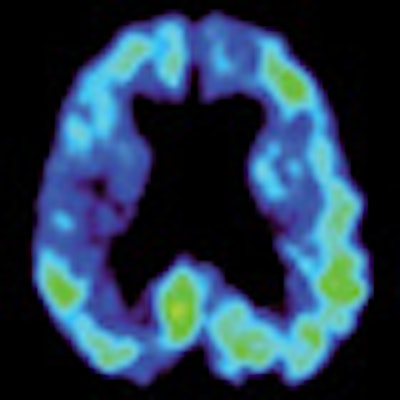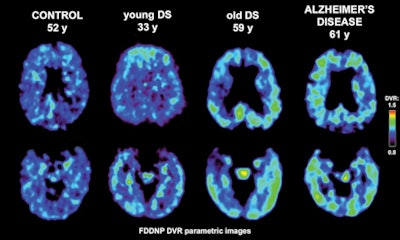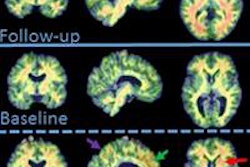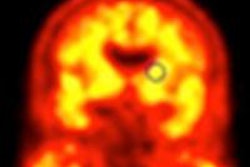
Using PET and the radiotracer FDDNP, California researchers are assessing the levels of amyloid plaques and neurofibrillary tangles -- characteristics of Alzheimer's disease -- in adults with Down syndrome, according to a study in the June issue of Archives of Neurology.
The findings may offer additional help in diagnosing dementia in adults with Down syndrome, who often develop Alzheimer's-like plaque and tangle deposits before the age of 40.
Study senior author Dr. Gary Small, a professor at the Semel Institute for Neuroscience and Human Behavior at the University of California, Los Angeles (UCLA), said early detection could lead to earlier interventions and treatments, often before symptoms begin.
The chemical marker FDDNP was developed by UCLA and is designed to bind to both plaque and tangle deposits, which can then be viewed on a PET scan.
The researchers administered F-18 FDDNP intravenously and performed PET brain scans on 19 patients with Down syndrome but no dementia (mean age, 36.7 years), 10 healthy controls (mean age, 43.8 years), and 10 patients with Alzheimer's disease (mean age, 66.5 years).
The results showed significantly higher binding levels of F-18 FDDNP in subjects with Down syndrome in all brain regions compared to healthy controls. When compared with the Alzheimer's group, the individuals with Down syndrome showed significantly higher binding levels in the parietal and frontal regions, which are associated with memory, behavior, and reasoning.
 |
| FDDNP-PET brain scans of control subject (left) shows minimal binding compared to the other subjects. The older Down syndrome subject (center right) shows higher binding than the younger Down syndrome subject (center left). Yellow and green correspond to greater binding values, while blue corresponds to less binding. Images courtesy of UCLA. |
"The higher level of plaques and tangles may be reflecting the early and extensive accumulation of these deposits seen in individuals with Down syndrome," Small said.
In the Down syndrome group, the researchers also found significant associations between increased age and greater F-18 FDDNP binding in the parietal, lateral temporal, and frontal regions.
Study co-author Jorge Barrio, PhD, a professor of molecular and medical pharmacology at UCLA's David Geffen School of Medicine, added that the age-related patterns and regional distribution of the plaques and tangles were consistent with the types of deposits that could only be identified previously through autopsy.
As part of the study, the researchers also performed cognitive and behavioral assessments of the Down syndrome patients to determine any correlations with F-18 FDDNP binding levels. Small and colleagues found several positive correlations with behavior abnormalities associated with these brain changes, including indifference and inappropriateness.
Cognitive skills in people with Down syndrome vary considerably and may not have been captured completely in the assessment, which primarily measured memory function, Small noted. Larger future studies will compare other cognitive tests with FDDNP binding values, he said.



















